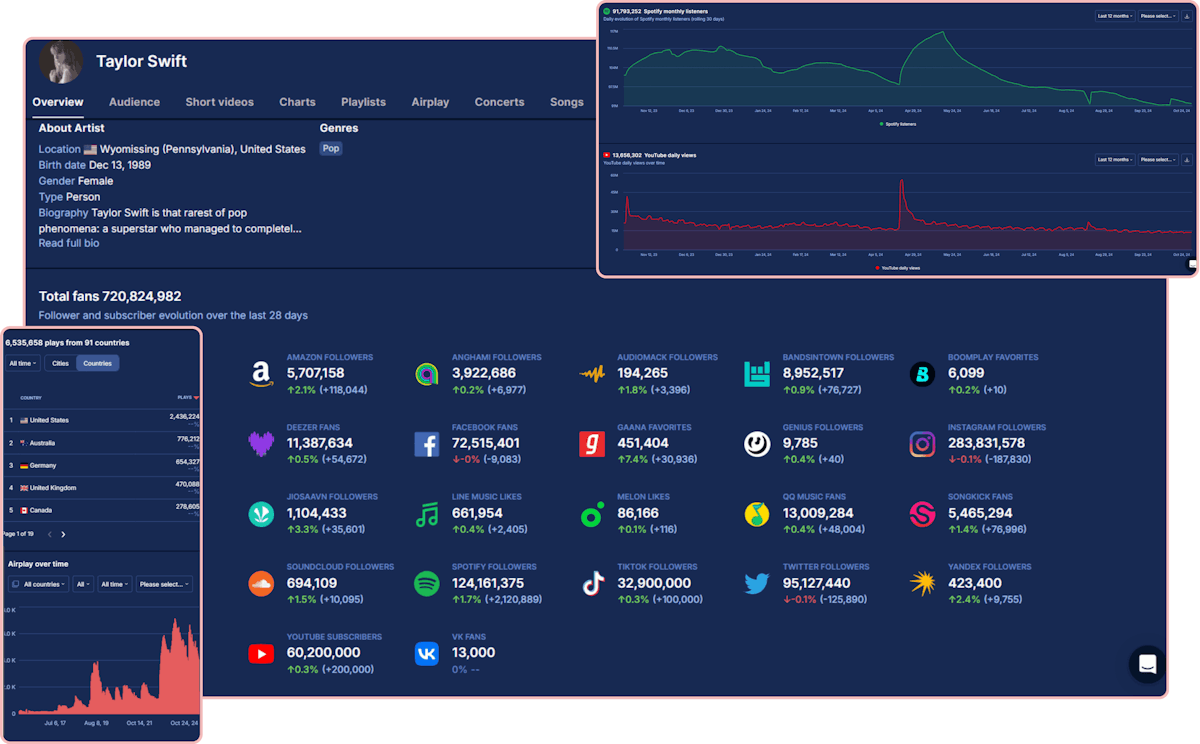Jump to
- 1. Understanding key data sources
- a. Streaming platforms
- b. Social networks
- c. Sales and downloads
- d. Websites and newsletters
- 2. Making the most of data with Base for Music and Soundcharts
- a. Base for Music: Simplified marketing campaigns
- b. Soundcharts: Monitoring music industry trends and audiences
- 3. Analyze the data to define your audience
- a. Segment your audience
- b. Identify Trends
- c. Personalize messages
- 4. Optimizing your content strategy
- a. Create data-driven content
- b. Plan your posts
- c. Use A/B tests
- 5. Measuring and adjusting your campaign
- a. Set clear objectives
- b. Track performance in real-time
- c. Analyze the results
- Conclusion
Data analysis is essential to running effective marketing campaigns in the modern music industry. By harnessing information from various sources, artists and marketing teams can make informed decisions, accurately target their audience, and maximize the impact of their music marketing strategies.
In this article, we'll explore how to use data to run a successful music marketing campaign, highlighting two essential tools: Base for Music and Soundcharts.
1. Understanding key data sources
Knowing where to find the most out of data and how to exploit it is crucial to getting the most out of it. Here are some key sources:
a. Streaming platforms
Platforms like Spotify, Apple Music, and Deezer provide valuable data on user's listening habits. You can analyze the number of listens, listener demographics, and the playlists in which your music is included. This information is crucial for understanding your audience and adapting your music marketing strategy.
b. Social networks
Facebook, Instagram, Twitter, and TikTok offer detailed data on your audience's engagement. Metrics such as likes, shares, comments, and reach allow you to identify the content that appeals most to your audience.
c. Sales and downloads
Platforms like iTunes, Bandcamp, and Amazon Music provide data on music sales. This information can help you understand your audience's buying preferences and effectively target your marketing efforts.
d. Websites and newsletters
Website analytics tools (such as Google Analytics) and emailing platforms (such as Mailchimp) enable you to track visitor behavior and evaluate engagement rates with your content. This helps you optimize your website and email campaigns.
2. Making the most of data with Base for Music and Soundcharts
To fully exploit the potential of data, two tools stand out: Base for Music and Soundcharts. These complementary tools form a complete solution for maximizing the impact of your music marketing campaigns.
a. Base for Music: Simplified marketing campaigns
Base for Music allows you to centralize data related to your music project in one place. This unique dashboard provides an overview of your social networks, artist accounts on streaming platforms, and advertising campaigns.

Base for Music's dashboard
- Centralize personal data: Track and aggregate fan information, audience growth, and engagement rates to understand better and target your audience.
- Launch marketing campaigns: Use this centralized data to design and launch personalized, strategic marketing campaigns, tracking their effectiveness and adjusting your actions in real-time to maximize results.
- Complementary tools: Base for Music also offers tools such as smart links, which bring all your content together in a single link, making sharing and optimizing your music marketing campaigns easy.
b. Soundcharts: Monitoring music industry trends and audiences
Soundcharts offers a global perspective, allowing you to monitor your performance and that of your competitors and the music industry. This tool is essential for understanding your marketing positioning and identifying growth opportunities.

Soundcharts' artist overview
- Industry trend tracking: Gain real-time insights into industry performance, radio airplay, playlist additions, and the positioning of other artists to spot growth opportunities.
- Audience analysis: Track the behavior of your audience and fans of other artists, enabling you to adjust your strategies in line with changes in the music market.
- Radio airplay and playlists: Track in real-time where and when your tracks are played on the radio or added to playlists, and identify the key stations and playlists for your musical genre.
3. Analyze the data to define your audience
Once you've centralized your data with Base for Music and enriched it with Soundcharts, it's time to define and segment your audience for more targeted campaigns.
a. Segment your audience
Use demographic (age, gender, location) and behavioral (listening habits, social network interactions) data to segment your audience into distinct groups. This segmentation enables you to personalize your marketing messages according to the preferences of each group.
b. Identify Trends
With Soundcharts, analyze industry listening and engagement trends. Identify the types of content and messages that resonate most with each segment of your audience.
c. Personalize messages
Create messages and content tailored to each segment of your audience using the data collected with Base for Music and Souncharts. For example. If a segment responds well to live videos, focus your efforts on this type of content for them.
4. Optimizing your content strategy
a. Create data-driven content
With Base for Music, you can determine which types of content (video, audio, text) most captivate your audience. use this data to refine your content strategy and maximize engagement.
b. Plan your posts
Analyze the times when your audience is most active on social networks to optimize the timing of your publications. The engagement data will tell you the best days and times to publish.
c. Use A/B tests
Use A/B tests to experiment with different types of content and messages. Compare performance and adjust your strategy accordingly to improve results.
5. Measuring and adjusting your campaign
a. Set clear objectives
Identify the objectives you want to achieve for your marketing campaigns. Base for Music lets you track these indicators and measure their evolution in real-time.
b. Track performance in real-time
Track your campaign's performance in real-time with Base for Music. Use Soundcharts to monitor industry trends and adjust your strategy if necessary.
c. Analyze the results
At the end of the campaign, combine the data from Base for Music and Soundcharts to assess what worked and what can be improved. Use these insights to refine your future campaigns.
Conclusion
Data is essential to a successful music marketing campaign. By understanding where to find information, how to analyze it, and how to use it to define your audience, optimize your content, and measure your results, you can maximize the impact of your promotional efforts.
With tools like Base for Music and Soundcharts, accessing specific and global data has never been easier. Base for Music centralizes your data, while Soundcharts offers an overview of the music industry, helping you to understand your positioning and monitor the competition. These complementary services form a powerful combination for fine-tuning your marketing strategies and achieving your objectives more effectively.
Want to know more about optimizing your music marketing campaigns? Access Soundcharts to harness data and discover our partnership with Base for Music to maximize your success with an exclusive offer!



